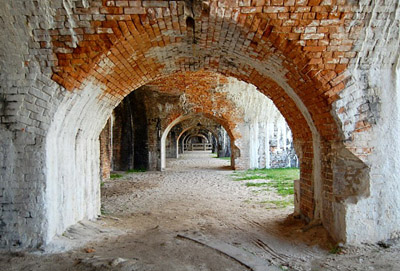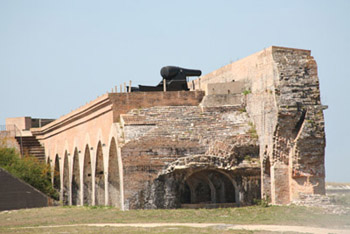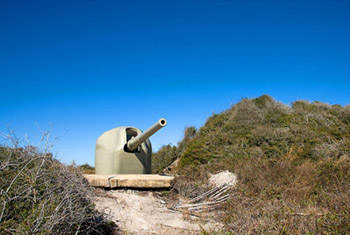 |
Fort Pickens
Santa Rosa Island, Florida
|
|
 |
The War of 1812 (1812-1815) had been a relatively positive experience for the United States (some of those who lost their lives might disagree, but they're not answering my interview requests), but a glaring deficiency in US coastal defense was made quite plain by such events as the burning of Washington DC by British troops, who had no trouble whatsoever in getting there. Upon completion of this war, the US determined to strengthen its defenses at all of its major seaports.
The Spanish and French had, through the 16th to 18th centuries, played various reindeer games in and around Florida. A few Spanish fortifications had been built to defend the lovely natural harbor that would become Pensacola, but all of Florida was ceded to Great Britain in 1763, as a result of the French and Indian War
|
 |
|
|
(1754-1763). Taking advantage of the American Revolution (1775-1783), Spain took Pensacola back from Britain in 1781, and got most of Florida back from the British at the end of the conflict. Finally, the US purchase of the Floridas for $5 million was negotiated in the Adams-Onis Treaty (1819): This treaty also set the boundary between the US and "The Viceroyalty of New Spain," which we know as Mexico.
After the War of 1812, French Engineer Simon Bernard (1779-1839) was appointed to design a fort that would defend the approaches to Pensacola Harbor. The fort was named for Major General Andrew Pickens (1739-1817) of the South Carolina Militia, who fought in the American Revolution.
|
 Fort Pickens is mostly bricks. 21.5 million of them. Fort Pickens is mostly bricks. 21.5 million of them.
I do so love bricks when they're assembled in this manner. |
 |
Fort Pickens was built from 1829 to 1834, out of 21.5 million bricks...mostly utilizing slave labor. Good ole slaves! Uncomplainingly building stuff! The fort supported Fort McRee on the other side of the inlet, and Fort Barrancas, previously known as Fort San Carlos de Barrancas, which, as you may have guessed, was Spanish in origin.
Fort Pickens was manned continuously through the Mexican-American War (1846-1848), but abandoned shortly thereafter...it was thus a somewhat dilapidated Fort Pickens that Federal forces under Lieutenant Adam Slemmer
|
|
(1828-1868) occupied at the beginning of January 1861. Slemmer was in command of Fort Barrancas when, around midnight on January 8, 1861, his men repelled an attack by locals who had hoped to capture that fort (the shots fired in this fracas are arguably the first of the US Civil War (1861-1865), predating the attack on Fort Sumter by more than three months). The quick-thinking Slemmer determined that Fort Pickens was a much more defensible position than Forts Barrancas or McRhee, so he spiked the guns at Barrancas, blew up 20,000 pounds of gunpowder at McRhee, and evacuated his 80 men to Fort Pickens...all of this just after Florida seceded from the Union on January 10, but long before war was declared by anyone! Lieutenant Slemmer receives a posthumous Starforts.com Gallantry Award, with oak leaf cluster.
|
Pensacola was left to the rebels, but Fort Pickens stayed in Union hands throughout the war. It was one of four southern US forts to do so: Fort Monroe at Hampton Roads, Virginia; Fort Jefferson in the Dry Tortugas off the Florida Keys; Fort Zachary Taylor at Key West, Florida (thanks to David Ogden of the National Park Service for that tidbit!); and Fort Pickens. On the night of October 9, 1861, Confederate General Braxton Bragg (1817-1876) led a force across the bay to attack Fort Pickens, but succeeded only in taking on the 6th NY Infantry Regiment, which was at Camp Brown, about a mile east of the fort. Some 1800 men were involved in the battle, which resulted in 150 casualties. Undefeated, Fort Pickens retaliated for this intended affront by shelling everything within its range on November 22 & 23, 1861: With the broadsides of the USS Richmond and USS Niagra in assistance, the Confederate-occupied Forts McRee and Barrancas were heavily damaged, along with Pensacola's Navy Yard and several independent rebel batteries along the shore. |
 |
Fort Barrancas. The lighter-colored portion is the Water Battery, built by the Spanish in 1787; the triangular portion was built (by Americans, likely of the darker-skinned variety) out of brick in 1839. |
|
Confederate forces withdrew from Pensacola Bay in May of 1862, at least in part due to their inability to capture Fort Pickens.
Apache Indian chief Geronimo (1829-1909) and several of his warriors were imprisoned at Fort Pickens from October 1886 to May 1887, in what must have been a culture shock for everyone involved. The Army had initially intended to keep Geronimo at Fort Marion in Pensacola, but locals felt he should be somewhere other than where they were, and a petition to that effect was presented to the government. When Geronimo, 17 of his warriors and their guards steamed to Fort Pickens in 1886 it had been uninhabited for twenty years, and guards and prisoners alike had to get creative in the interest of sheltering themselves. The Apaches were put to work seven hours a day, clearing brush. Geronimo and co. were eventually moved to Fort Sill in Oklahoma, where the wrinkled Apache died in 1909.
Vast sums of money were made available for the upgrade of Fort Pickens' guns by the Endicott Board, an effort by US President Grover Cleveland (1837-1908)'s administration to make American seacoast defenses capable of actually defending something. Between 1898 and 1906, eight separate (slab-sided, ugly) batteries were built at and around Fort Pickens, most notably Battery Pensacola, which mounted two 12" disappearing guns, right there in the middle of the starfort.
On June 20 1899, a fire in one of Fort Pickens' pointy bastions reached its powder magazine, which held 8,000 pounds of powder. The following explosion killed one man and completely obliterated the bastion that is still quite demonstrably missing today...rubble from the blast landed on Fort Barrancas, 1.5 miles away.
|
 A 15" Rodman Gun, now in its second century of defending Pensacola Harbor from the Confederacy A 15" Rodman Gun, now in its second century of defending Pensacola Harbor from the Confederacy |
 |
 A 6" Shielded Barbette Gun from Battery 234, built in 1943...though the Kriegsmarine never tried, surely it would've enjoyed as little success as the Southrons A 6" Shielded Barbette Gun from Battery 234, built in 1943...though the Kriegsmarine never tried, surely it would've enjoyed as little success as the Southrons |
|
The US Army's Coastal Artillery folks kept beavering away at Fort Pickens through the first half of the 20th century, adding another battery during the First World War (1914-1918) in Battery Langdon, built in 1917 and supporting two long-range 12" guns.
In early 1942, German U-Boats sunk some US shipping in the Gulf of Mexico, which naturally freaked a great many Americans out. Another three batteries were constructed in 1942 and 1943 at Fort Pickens, but gun tubes were not delivered to all of them, due to the lessening of anxiety once the US Navy got on its feet and started sinking U-Boats.
Fort Pickens closed as an army installation in 1947. The fort's grounds became part of a state park, which was closed for several years of maintenance but reopened to the public in 1976. Today, Fort Pickens boasts plenty of historical guns for you to poke at, including two Civil War Rodman guns, a 6" Endicott-Era gun on a disappearing carriage, and a couple of 6" rapid-fire guns in Shielded Barbette Carriages.
|
|
|
|
|
|
 |




